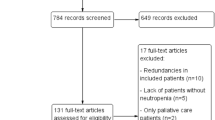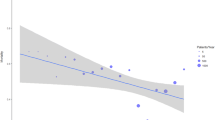Abstract
Purpose
The prognosis of critically ill cancer patients has improved recently. Controversies remain as regard to the specific prognosis impact of neutropenia in critically ill cancer patients. The primary objective of this study was to assess hospital outcome of critically ill neutropenic cancer patients admitted into the ICU. The secondary objective was to assess risk factors for unfavorable outcome in this population of patients and specific impact of neutropenia.
Methods
We performed a post hoc analysis of a prospectively collected database. The study was carried out in 17 university or university-affiliated centers in France and Belgium. Neutropenia was defined as a neutrophil count lower than 500/mm3.
Results
Among the 1,011 patients admitted into the ICU during the study period 289 were neutropenic at the time of admission. Overall, 131 patients died during their hospital stay (hospital mortality 45.3 %). Four variables were associated with a poor outcome, namely allogeneic transplantation (OR 3.83; 95 % CI 1.75–8.35), need for mechanical ventilation (MV) (OR 6.57; 95 % CI 3.51–12.32), microbiological documentation (OR 2.33; CI 1.27–4.26), and need for renal replacement therapy (OR 2.77; 95 % CI 1.34–5.74). Two variables were associated with hospital survival, namely age younger than 70 (OR 0.22; 95 % CI 0.1–0.52) and neutropenic enterocolitis (OR 0.37; 95 % CI 0.15–0.9). A case–control analysis was also performed with patients of the initial database; after adjustment, neutropenia was not associated with hospital mortality (OR 1.27; 95 % CI 0.86–1.89).
Conclusion
Hospital survival was closely associated with younger age and neutropenic enterocolitis. Conversely, need for conventional MV, for renal replacement therapy, and allogeneic hematopoietic stem cell transplantation (HSCT) were associated with poor outcome.


Similar content being viewed by others
References
Recher C, Coiffier B, Haioun C, Molina TJ, Ferme C, Casasnovas O et al (2011) Intensified chemotherapy with ACVBP plus rituximab versus standard CHOP plus rituximab for the treatment of diffuse large B-cell lymphoma (LNH03-2B): an open-label randomised phase 3 trial. Lancet 378:1858–1867
Vogelzang NJ, Benowitz SI, Adams S, Aghajanian C, Chang SM, Dreyer ZE et al (2012) Clinical cancer advances 2011: annual report on progress against cancer from the American Society of Clinical Oncology. J Clin Oncol 30:88–109
Zuber B, Tran TC, Aegerter P, Grimaldi D, Charpentier J, Guidet B et al (2012) Impact of case volume on survival of septic shock in patients with malignancies. Crit Care Med 40:55–62
Azoulay E, Mokart D, Rabbat A, Pene F, Kouatchet A, Bruneel F et al (2008) Diagnostic bronchoscopy in hematology and oncology patients with acute respiratory failure: prospective multicenter data. Crit Care Med 36:100–107
Vincent F, Hospital MA, Lemiale V, Bruneel F, Darmon M, Gonzalez F et al (2012) Therapeutic of respiratory manifestations at the early phase of acute myeloid leukaemia. Rev Mal Respir 29:743–755
Legrand M, Max A, Peigne V, Mariotte E, Canet E, Debrumetz A et al (2012) Survival in neutropenic patients with severe sepsis or septic shock. Crit Care Med 40:43–49
Mokart D, van CT, Lambert J, Textoris J, Brun JP, Sannini A et al (2012) Prognosis of acute respiratory distress syndrome in neutropenic cancer patients. Eur Respir J 40:169–176
Mokart D, Azoulay E, Schnell D, Bourmaud A, Kouatchet A, Pene F et al (2013) Acute respiratory failure in neutropenic patients is associated with a high post-ICU mortality. Minerva Anestesiol 79:1156–1163
Vanneman M, Dranoff G (2012) Combining immunotherapy and targeted therapies in cancer treatment. Nat Rev Cancer 12:237–251
Maschmeyer G, Carratala J, Buchheidt D, Hamprecht A, Heussel CP, Kahl C et al (2015) Diagnosis and antimicrobial therapy of lung infiltrates in febrile neutropenic patients (allogeneic SCT excluded): updated guidelines of the Infectious Diseases Working Party (AGIHO) of the German Society of Hematology and Medical Oncology (DGHO). Ann Oncol 26:21–33
Maschmeyer G, Beinert T, Buchheidt D, Cornely OA, Einsele H, Heinz W et al (2009) Diagnosis and antimicrobial therapy of lung infiltrates in febrile neutropenic patients: guidelines of the infectious diseases working party of the German Society of Haematology and Oncology. Eur J Cancer 45:2462–2472
Mokart D, Textoris J, Ettori F, Chetaille B, Blache JL (2011) Acute respiratory distress syndrome (ARDS) in neutropenic patients. In: Azoulay E (ed) Pulmonary involvement in patients with hematological malignancies. Springer, Berlin Heidelberg, pp 477–490
Zafrani L, Azoulay E (2014) How to treat severe infections in critically ill neutropenic patients? BMC Infect Dis 14:512
Azoulay E, Mokart D, Pene F, Lambert J, Kouatchet A, Mayaux J et al (2013) Outcomes of critically ill patients with hematologic malignancies: prospective multicenter data from France and Belgium—a groupe de recherche respiratoire en reanimation onco-hematologique study. J Clin Oncol 31:2810–2818
Vincent JL, de MA, Cantraine F, Moreno R, Takala J, Suter PM et al (1998) Use of the SOFA score to assess the incidence of organ dysfunction/failure in intensive care units: results of a multicenter, prospective study. Working group on “sepsis-related problems” of the European Society of Intensive Care Medicine. Crit Care Med 26:1793–1800
Oken MM, Creech RH, Tormey DC, Horton J, Davis TE, McFadden ET et al (1982) Toxicity and response criteria of the Eastern Cooperative Oncology Group. Am J Clin Oncol 5:649–655
Charlson ME, Sax FL, MacKenzie CR, Braham RL, Fields SD, Douglas RG Jr (1987) Morbidity during hospitalization: can we predict it? J Chronic Dis 40:705–712
Azoulay E, Mokart D, Lambert J, Lemiale V, Rabbat A, Kouatchet A et al (2010) Diagnostic strategy for hematology and oncology patients with acute respiratory failure: randomized controlled trial. Am J Respir Crit Care Med 182:1038–1046
Mourad M, Chow-Chine L, Faucher M, Sannini A, Brun JP, de Guibert JM et al (2014) Early diastolic dysfunction is associated with intensive care unit mortality in cancer patients presenting with septic shock. Br J Anaesth 112:102–109
Mourad M, Chow-Chine L, Faucher M, Sannini A, Brun JP, de Guibert JM et al (2013) Early diastolic dysfunction is associated with intensive care unit mortality in cancer patients presenting with septic shock. Br J Anaesth 112(1):102–109
De PB, Walsh TJ, Donnelly JP, Stevens DA, Edwards JE, Calandra T et al (2008) Revised definitions of invasive fungal disease from the European Organization for Research and Treatment of Cancer/Invasive Fungal Infections Cooperative Group and the National Institute of Allergy and Infectious Diseases Mycoses Study Group (EORTC/MSG) Consensus Group. Clin Infect Dis 46:1813–1821
Resche-Rigon M, Azoulay E, Chevret S (2006) Evaluating mortality in intensive care units: contribution of competing risks analyses. Crit Care 10:R5
Darmon M, Azoulay E, Alberti C, Fieux F, Moreau D, Le Gall JR et al (2002) Impact of neutropenia duration on short-term mortality in neutropenic critically ill cancer patients. Intensive Care Med 28:1775–1780
Pene F, Aubron C, Azoulay E, Blot F, Thiery G, Raynard B et al (2006) Outcome of critically ill allogeneic hematopoietic stem-cell transplantation recipients: a reappraisal of indications for organ failure supports. J Clin Oncol 24:643–649
Azoulay E, Thiery G, Chevret S, Moreau D, Darmon M, Bergeron A et al (2004) The prognosis of acute respiratory failure in critically ill cancer patients. Medicine (Baltimore) 83:360–370
Buchner T, Berdel WE, Wormann B, Schoch C, Haferlach T, Schnittger S et al (2005) Treatment of older patients with AML. Crit Rev Oncol Hematol 56:247–259
Coiffier B, Lepage E, Briere J, Herbrecht R, Tilly H, Bouabdallah R et al (2002) CHOP chemotherapy plus rituximab compared with CHOP alone in elderly patients with diffuse large-B-cell lymphoma. N Engl J Med 346:235–242
Thieblemont C, Coiffier B (2007) Lymphoma in older patients. J Clin Oncol 25:1916–1923
Rhee CK, Kang JY, Kim YH, Kim JW, Yoon HK, Kim SC et al (2009) Risk factors for acute respiratory distress syndrome during neutropenia recovery in patients with hematologic malignancies. Crit Care 13:R173
Karlin L, Darmon M, Thiery G, Ciroldi M, de Miranda S, Lefebvre A et al (2005) Respiratory status deterioration during G-CSF-induced neutropenia recovery. Bone Marrow Transplant 36:245–250
Berghmans T, Paesmans M, Lafitte JJ, Mascaux C, Meert AP, Jacquy C et al (2002) Therapeutic use of granulocyte and granulocyte–macrophage colony-stimulating factors in febrile neutropenic cancer patients. A systematic review of the literature with meta-analysis. Support Care Cancer 10:181–188
Hohenberger P, Buchheidt D (2005) Surgical interventions in patients with hematologic malignancies. Crit Rev Oncol Hematol 55:83–91
Badgwell BD, Cormier JN, Wray CJ, Borthakur G, Qiao W, Rolston KV et al (2008) Challenges in surgical management of abdominal pain in the neutropenic cancer patient. Ann Surg 248:104–109
Cronin CG, O’Connor M, Lohan DG, Keane M, Roche C, Bruzzi JF et al (2009) Imaging of the gastrointestinal complications of systemic chemotherapy. Clin Radiol 64:724–733
Annane D, Sebille V, Charpentier C, Bollaert PE, Francois B, Korach JM et al (2002) Effect of treatment with low doses of hydrocortisone and fludrocortisone on mortality in patients with septic shock. JAMA 288:862–871
Ferrer R, Artigas A, Levy MM, Blanco J, Gonzalez-Diaz G, Garnacho-Montero J et al (2008) Improvement in process of care and outcome after a multicenter severe sepsis educational program in Spain. JAMA 299:2294–2303
Freifeld AG, Bow EJ, Sepkowitz KA, Boeckh MJ, Ito JI, Mullen CA et al (2011) Clinical practice guideline for the use of antimicrobial agents in neutropenic patients with cancer: 2010 update by the Infectious Diseases Society of America. Clin Infect Dis 52:427–431
Canet E, Zafrani L, Lambert J, Thieblemont C, Galicier L, Schnell D et al (2013) Acute kidney injury in patients with newly diagnosed high-grade hematological malignancies: impact on remission and survival. PLoS One 8:e55870
Munker R, Hill U, Jehn U, Kolb HJ, Schalhorn A (1998) Renal complications in acute leukemias. Haematologica 83:416–421
Conflicts of interest
None.
Author information
Authors and Affiliations
Corresponding author
Additional information
A study from the Groupe de Recherche en Réanimation Respiratoire en Onco-Hématologie (GRRROH), Paris, France (http://www.grrroh.com).
Take-home message: Hospital survival is closely associated with younger age and with neutropenic enterocolitis. Need for conventional MV, for renal replacement therapy, and allogeneic HSCT were associated with poor outcome.
Electronic supplementary material
Below is the link to the electronic supplementary material.
Rights and permissions
About this article
Cite this article
Mokart, D., Darmon, M., Resche-Rigon, M. et al. Prognosis of neutropenic patients admitted to the intensive care unit. Intensive Care Med 41, 296–303 (2015). https://doi.org/10.1007/s00134-014-3615-y
Received:
Accepted:
Published:
Issue Date:
DOI: https://doi.org/10.1007/s00134-014-3615-y




